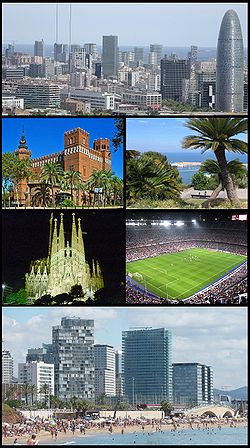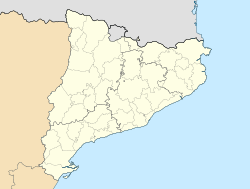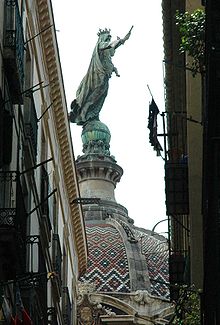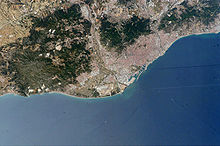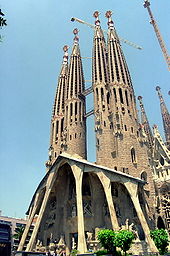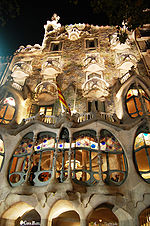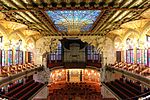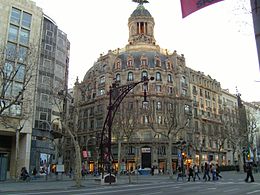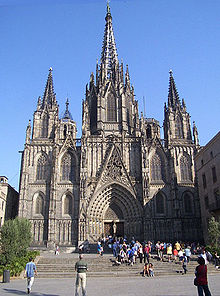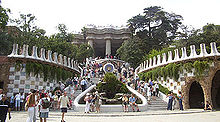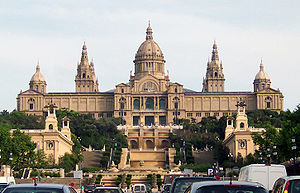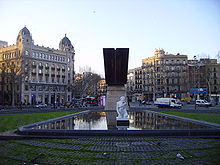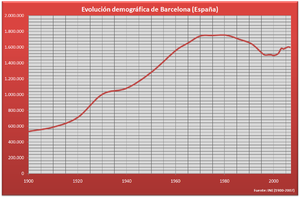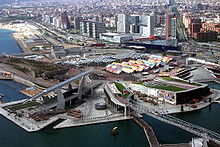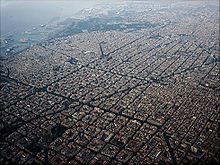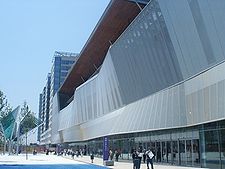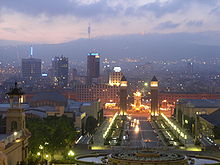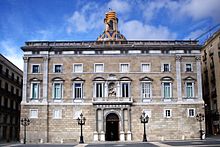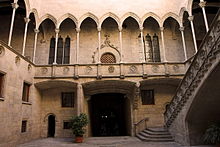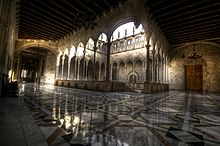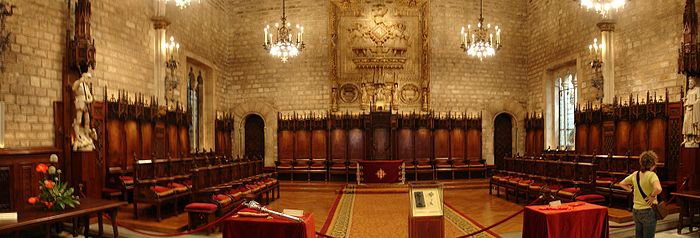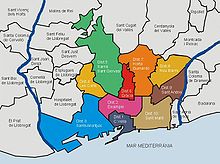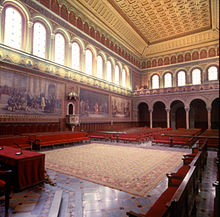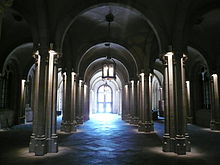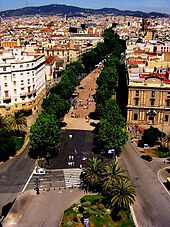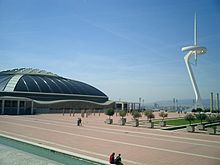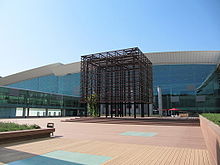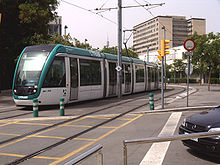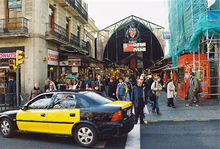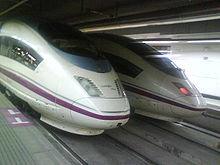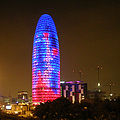- Barcelona
-
This article is about the capital of Catalonia. For the football club, see FC Barcelona. For other uses, see Barcelona (disambiguation).
Barcelona from top, left to right: Barcelona skyline, Castell dels Tres Dragons, Port of Barcelona, Sagrada Família, Camp Nou, Mar Bella beach 
Flag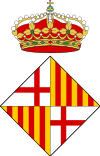
Coat of armsNickname(s): Ciudad Condal, Ciutat Comtal (City of Counts),
Barna,
BCNLocation of Barcelona within Spain Location of Barcelona within Catalonia Coordinates: 41°23′N 2°11′E / 41.383°N 2.183°ECoordinates: 41°23′N 2°11′E / 41.383°N 2.183°E Country  Spain
SpainAutonomous Community  Catalonia
CataloniaProvince Barcelona Comarca Barcelonès Districts Ciutat Vella, Eixample, Gràcia, Horta-Guinardó, Les Corts, Nou Barris, Sant Andreu, Sants–Montjuïc, Sarrià-Sant Gervasi, Sant Martí Government – Type Mayor-council – Body Ajuntament de Barcelona – Mayor Xavier Trias i Vidal de Llobatera (CiU) Area – City 101.9 km2 (39.3 sq mi) – Urban 803 km2 (310 sq mi) Elevation(AMSL) 12 m (39 ft) Population (2009) – City 1,621,537
3,218,071 (Greater Barcelona)– Density 15,991/km2 (41,416.5/sq mi) – Urban 4,210,000 
– Urban zone 4,440,629 
– Metropolitan 5,083,000 
Demonym Barcelonan
barceloní, barcelonina
barcelonés, barcelonesaTime zone CET (UTC+1) – Summer (DST) CEST (UTC+2) Postal code 08001–08080 Area code +34 (Spain) 93 (City) Website www.bcn.cat Barcelona (Catalan: [bərsəˈɫonə], Spanish: [barθeˈlona]) is the capital and the most populous city of Catalonia and the second largest city in Spain, after Madrid, with a population of 1,621,537 within its administrative limits on a land area of 101.4 km2 (39 sq mi). The urban area of Barcelona extends beyond the administrative city limits with a population of between 4,200,000[1] and 4,500,000[2] on an area of 803 km2 (310 sq mi),[1] being the sixth-most populous urban area in the European Union after Paris, London, Ruhr area, Madrid and Milan. About five million[3][4][5] people live in the Barcelona metropolitan area. It is also Europe's largest metropolis on the Mediterranean coast. It is the main component of an administrative area of Greater Barcelona, with a population of 3,218,071 in an area of 636 km² (density 5,060 hab/km²). It is located on the Mediterranean coast between the mouths of the rivers Llobregat and Besòs and is bounded to the west by the Serra de Collserola ridge (512 m/1,680 ft).
Barcelona is today one of the world's leading tourist, economic, trade fair/exhibitions and cultural-sports centres, and its influences in commerce, education, entertainment, media, fashion, science, and the arts all contribute to its status as one of the world's major global cities.[6][7] Indeed, it is a major economic centre and a growing financial centre (Diagonal Mar area and Gran Via); one of Europe's principal Mediterranean ports, can be found here as well as Barcelona international airport, which handles about 30 million passengers per year. It also boasts an extensive motorway network and is a hub of high-speed rail, particularly that which will link France with Spain. Barcelona is the 16th-most-visited city in the world and 4th most visited in Europe after Paris, London, and Rome, with several million tourists every year.[8] Barcelona is the 16th most "livable city" in the world according to lifestyle magazine Monocle.[9] Similarly, according to Innovation Analysts 2thinknow, Barcelona occupies 13th place in the world on Innovation Cities™ Global Index.[10] It is the 4th richest city by GDP in the European Union and 35th in the world with an output amounting to €177 billion, a figure nonetheless smaller than alternative estimates.[11] Consequently, its GDP per capita output stands at €39,859 – some 44% higher than the European Union average and GDP per head is €80,894 according to Eurostat.[12] Similarly, the city of Barcelona stands in 29th place in a list of net personal earnings headed by Zurich.[13] The city is Europe's 3rd and one of the world's most successful as a city brand, both in terms of reputation and assets.[14] Barcelona is 7th most important fashion capital in the world. Also, the city is Europe's 4th best business city and fastest improving European city, with growing improved by 17% per year.[15]
Founded as a Roman city, Barcelona became the capital of the Counts of Barcelona. After merging with the Kingdom of Aragon, Barcelona became one of the most important cities of the Crown of Aragon. Besieged several times during its history, Barcelona is today an important cultural centre and a major tourist destination and has a rich cultural heritage. Particularly renowned are architectural works of Antoni Gaudí and Lluís Domènech i Montaner that have been designated UNESCO World Heritage Sites. The city is well known in recent times for the 1992 Summer Olympics. The headquarters of the Union for the Mediterranean is located in Barcelona.
As the capital of Catalonia, Barcelona houses the seat of the Catalan government, known as the Generalitat de Catalunya; of particular note are the executive branch, the parliament, and the Supreme Court of Catalonia. The city is also the capital of the Province of Barcelona and the Barcelonès comarca (shire).
Contents
Names
The name Barcelona comes from the ancient Iberian Phoenician Barkeno, attested in an ancient coin inscription in Iberian script as
 ,[16] in Ancient Greek sources as Βαρκινών, Barkinṓn;[17] and in Latin as Barcino[citation needed], Barcilonum[18] and Barceno.[19][citation needed]
,[16] in Ancient Greek sources as Βαρκινών, Barkinṓn;[17] and in Latin as Barcino[citation needed], Barcilonum[18] and Barceno.[19][citation needed]During the Middle Ages, the city was variously known as Barchinona, Barçalona, Barchelona, and Barchenona.
Some sources say that the city could have been named after the Carthaginian general Hamilcar Barca, who was supposed to have founded the city in the 3rd century BC.[20]
History
The founding of Barcelona is the subject of two different legends. The first attributes the founding of the city to the mythological Hercules 400 years before the building of Rome. The second legend attributes the foundation of the city directly to the historical Carthaginian Hamilcar Barca, father of Hannibal, who named the city Barcino after his family in the 3rd century BC.[21]
About 15 BC, the Romans redrew the town as a castrum (Roman military camp) centred on the "Mons Taber", a little hill near the contemporary city hall (Plaça de Sant Jaume). Under the Romans, it was a colony with the surname of Faventia,[22] or, in full, Colonia Faventia Julia Augusta Pia Barcino[23] or Colonia Julia Augusta Faventia Paterna Barcino. Mela[24] mentions it among the small towns of the district, probably as it was eclipsed by its neighbour Tarraco (modern Tarragona), but it may be gathered from later writers that it gradually grew in wealth and consequence, favoured as it was with a beautiful situation and an excellent harbour.[25] It enjoyed immunity from imperial burdens.[26] The city minted its own coins; some from the era of Galba survive.
Some important Roman ruins are exposed under the Plaça del Rei, entrance by the city museum (Museu d'Història de la Ciutat), and the typically Roman grid-planning is still visible today in the layout of the historical centre, the Barri Gòtic ("Gothic Quarter"). Some remaining fragments of the Roman walls have been incorporated into the cathedral.[27] The cathedral, also known as basilica La Seu, is said to have been founded in 343. The city was conquered by the Visigoths in the early 5th century, becoming for a few years the capital of the whole Hispania. After being conquered by the Arabs in the early 8th century, it was reconquered in 801 by Charlemagne's son Louis, who made Barcelona the seat of Carolingian "Spanish Marches" (Marca Hispanica), a buffer zone ruled by the Count of Barcelona.
The Counts of Barcelona became increasingly independent and expanded their territory to include all of Catalonia. In 1137, Aragon and the County of Barcelona merged by dynastic union[28][29] by the marriage of Ramon Berenguer IV and Petronilla of Aragon, and their titles were finally borne by only one person when their son Alfonso II of Aragon ascended to the throne in 1162. His territories were later to be known as the Crown of Aragon, which conquered many overseas possessions, ruling the western Mediterranean Sea with outlying territories in Naples and Sicily and as far as Athens in the 13th century. The forging of a dynastic link between the Crowns of Aragon and Castile marked the beginning of Barcelona's decline.
The marriage of Ferdinand II of Aragon and Isabella I of Castile in 1469 united the two royal lines. The centre of political power became Madrid and the colonisation of the Americas reduced the financial importance (at least in relative terms) of Mediterranean trade. Barcelona was always the stronghold of Catalan separatism and was the center of the Catalan Revolt (1640–52) against Philip IV of Spain. The great plague of 1650–1654 halved the city's population.[30] The Napoleonic wars left the province ravaged, but the postwar period saw the start of industrialization.
In the eighteenth century a fortress was built at Montjuïc that overlooked the harbour. In 1794, this fortress was used by the French astronomer Pierre François André Méchain for observations relating to a survey stretching to Dunkirk that provided the basis of the metre.[31] The definitive metre bar, manufactured from platinum, was presented to the French legislative assembly on 22 June 1799.
The resistance of Barcelona to Franco's coup d'état was to have lasting effects after the defeat of the Republican government. The autonomous institutions of Catalonia were abolished,[32] and the use of the Catalan language in public life was suppressed. Barcelona remained the second largest city in Spain, at the heart of a region which was relatively industrialised and prosperous, despite the devastation of the civil war. The result was a large-scale immigration from poorer regions of Spain (particularly Andalucia, Murcia and Galicia), which in turn led to rapid urbanisation. Barcelona hosted the Olympic Games in 1992, which helped revitalize the city.[33]
Geography
Barcelona is located on the northeast coast of the Iberian Peninsula, facing the Mediterranean Sea, on a plateau approximately 5 km (3 mi) wide limited by the mountain range of Collserola, the Llobregat river to the southwest and the Besòs river to the north.[34] This plateau has 170 km2 (66 sq mi),[34] of which 101 km² (38.9 sq mi)[35] are occupied by the city itself. It is 120 km (75 mi) south of the Pyrenees and the Catalonian border with France.
Tibidabo, 512 m (1,680 ft) high, offers striking views over the city[36] and is topped by the 288.4 m (946.2 ft) Torre de Collserola, a telecommunications tower that is visible from most of the city. Barcelona is peppered with small hills, most of them urbanized and that gave their name to the neighbourhoods built upon them, such as Carmel (267 m), Putxet (181 m) and Rovira (261 m). The escarpment of Montjuïc (173 m), situated to the southeast, overlooks the harbour and is topped by Montjuïc castle, a fortress built in the 17–18th centuries to control the city as a replacement for the Ciutadella. Today, the fortress is a museum and Montjuïc is home to several sporting and cultural venues, as well as Barcelona's biggest park and gardens.
The city borders are the municipalities of Santa Coloma de Gramenet and Sant Adrià de Besòs to the north; the Mediterranean Sea to the east; El Prat de Llobregat and L'Hospitalet de Llobregat to the south; and Sant Feliu de Llobregat, Sant Just Desvern, Esplugues de Llobregat, Sant Cugat del Vallès, and Montcada i Reixac to the west.
Climate
Barcelona has a Mediterranean climate[37] (Köppen climate classification: Csa),[38] with mild, humid winters and warm, dry summers.
Its average annual temperature is 20 °C (68 °F) during the day and 11 °C (52 °F) at night. Average annual temperature of sea is about 18 °C (64 °F). In the coldest month – January, typically the temperature ranges from 8 to 17 °C (46 to 63 °F) during the day, 2 to 10 °C (36 to 50 °F) at night and the average sea temperature is 13 °C (55 °F).[39] In the warmest month – August, the typically temperature ranges from 25 to 31 °C (77 to 88 °F) during the day, about 20 °C (68 °F) at night and the average sea temperature is 25 °C (77 °F).[39] Generally – "summer's" / "holiday" season lasts about six months, from May to October. Two months – April and November – are transitional, sometimes temperature exceeds 20 °C (68 °F), with average temperature of 17–18 °C (63–64 °F) during the day and 8–9 °C (46–48 °F) at night. December, January and February are the coldest months, with average temperatures around 14 °C (57 °F) during the day and 5 °C (41 °F) at night. Large fluctuations in temperature are rare, particularly in summer months. Sunshine duration is 2,524 hours per year, from 138 (average 4.5 hours of sunshine at day) in December to 310 (average 10 hours of sunshine at day) in July.[40]
Climate data for Barcelona Month Jan Feb Mar Apr May Jun Jul Aug Sep Oct Nov Dec Year Average high °C (°F) 13.4
(56.1)14.6
(58.3)15.9
(60.6)17.6
(63.7)20.5
(68.9)24.2
(75.6)27.5
(81.5)28.0
(82.4)25.5
(77.9)21.5
(70.7)17.0
(62.6)14.3
(57.7)20.0 Daily mean °C (°F) 8.9
(48.0)10.0
(50.0)11.3
(52.3)13.1
(55.6)16.3
(61.3)20.0
(68.0)23.1
(73.6)23.7
(74.7)21.1
(70.0)17.1
(62.8)12.6
(54.7)10.0
(50.0)15.6 Average low °C (°F) 4.4
(39.9)5.3
(41.5)6.7
(44.1)8.5
(47.3)12.0
(53.6)15.7
(60.3)18.6
(65.5)19.3
(66.7)16.7
(62.1)12.6
(54.7)8.1
(46.6)5.7
(42.3)11.1 Precipitation mm (inches) 41
(1.61)39
(1.54)42
(1.65)49
(1.93)59
(2.32)42
(1.65)20
(0.79)61
(2.4)85
(3.35)91
(3.58)58
(2.28)51
(2.01)640
(25.2)Avg. precipitation days (≥ 1 mm) 5 4 5 5 5 4 2 4 5 6 5 5 55 Sunshine hours 149 163 200 220 244 262 310 282 219 180 146 138 2,524 Source: World Meteorological Organization (UN),[41] Agencia Estatal de Meteorología[40] Main sights
The Barri Gòtic ("Gothic Quarter" in Catalan) is the centre of the old city of Barcelona. Many of the buildings date from medieval times, some from as far back as the Roman settlement of Barcelona. Catalan modernisme architecture (often known as Art Nouveau in the rest of Europe), developed between 1885 and 1950 and left an important legacy in Barcelona. A great number of these buildings are World Heritage Sites. Especially remarkable is the work of architect Antoni Gaudí, which can be seen throughout the city. His best known work is the immense but still unfinished church of the Sagrada Família, which has been under construction since 1882, and is still financed by private donations. As of 2007, completion is planned for 2026.
Barcelona was also home to Mies van der Rohe's Barcelona Pavilion. Designed in 1929 for the International Exposition for Germany, it is an iconic building that came to symbolize modern architecture as the embodiment of van der Rohe's aphorisms "less is more" and "God is in the details." The Barcelona pavilion was intended as a temporary structure, and was torn down in 1930 less than a year after it was constructed. A modern re-creation by Spanish architects now stands in Barcelona, however, constructed in 1986.
Barcelona won the 1999 RIBA Royal Gold Medal for its architecture,[42] the first (and as of 2009, only) time that the winner has been a city, and not an individual architect.
Heritage
In Barcelona there are several points of interest declared World Heritage by UNESCO: [43]
Code Name Year Coordinates Image 320-001 Park Güell 1984 41°24′59.6″N 2°09′07.9″E / 41.416556°N 2.152194°E 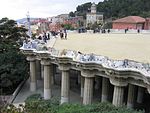
320-002 Palau Güell 1984 41°22′45″N 2°10′28″E / 41.379183°N 2.174445°E 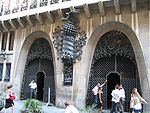
320-003 Casa Milà 1984 41°23′51.3″N 2°09′46.9″E / 41.397583°N 2.163028°E 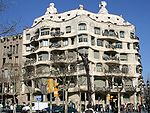
320-004 Casa Vicens 2005 41°22′50.5″N 2°10′30.6″E / 41.380694°N 2.175167°E 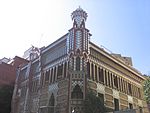
320-005 Facade of the Nativity and crypt of the Sagrada Familia 2005 41°24′19.8″N 2°10′30.2″E / 41.4055°N 2.175056°E 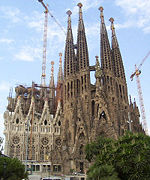
320-006 Casa Batlló 2005 41°22′00.3″N 2°09′59.0″E / 41.36675°N 2.16639°E 804-001 Palau de la Música Catalana 1997 41°23′16″N 2°10′30″E / 41.38778°N 2.175°E 804-002 Hospital de Sant Pau 1997 41°24′50″N 2°10′30″E / 41.41389°N 2.175°E 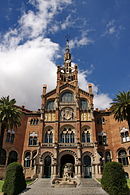
Historic buildings and monuments
Further information: List of Modernisme buildings in BarcelonaSee also Category: Buildings and structures in Barcelona.- Sagrada Família, the international symbol of Barcelona
- Palau de la Música Catalana and Hospital de Sant Pau, designed by Lluís Domènech i Montaner, included in the UNESCO Heritage List list in 1997.
- Works by Antoni Gaudí, including Park Güell, Palau Güell, Casa Milà (La Pedrera), Casa Vicens, Sagrada Família (Nativity façade and crypt), Casa Batlló, Crypt in Colonia Güell. The first three works were inscribed as a World Heritage Site in 1984. The other four were added as extensions to the site in 2005.
- The Cathedral of St. Eulalia
- Church of Santa Maria del Mar (Gothic)
- Gothic church of Santa Maria del Pi
- Church of Sant Pau del Camp
- Palau Reial Major, medieval residence of the counts of Barcelona and the Kings of Aragon
- The Columbus Monument
- Forum Building, an example of contemporary architecture
- The Arc de Triomf, a triumphal arch built in 1888
- Medieval church of Sant Pau del Camp
Museums
Barcelona has a great number of museums, which cover different areas and eras. The National Museum of Art of Catalonia possesses a well-known collection of Romanesque art while the Barcelona Museum of Contemporary Art focuses on post-1945 Catalan and Spanish art. The Fundació Joan Miró, Picasso Museum and Fundació Antoni Tàpies hold important collections of these world-renowned artists.
Several museums cover the fields of history and archeology, like the City History Museum, the Museum of the History of Catalonia, the Archeology Museum of Catalonia, the Barcelona Maritime Museum and the private-owned Egyptian Museum. The Erotic museum of Barcelona is among the most peculiar ones, while Cosmocaixa is a science museum that received the European Museum of the Year Award in 2006.
Parks
Barcelona contains 68 municipal parks, divided into 12 historic parks, 5 thematic (botanical) parks, 45 urban parks and 6 forest parks.[44] They range from vest-pocket parks to large recreation areas. The urban parks alone cover 10% of the city (549.7 ha/1,358.3 acres).[35] The total park surface grows about 10 ha (25 acres) per year,[45] with a proportion of 18.1 square metres (195 sq ft) of park area per inhabitant.[46]
Of Barcelona's parks, Montjuïc is the largest, with 203 ha located on the mountain of the same name.[35] It is followed by Parc de la Ciutadella (situated in the place of the old military citadel and which houses the Parliament building, the Barcelona Zoo and several museums; 31 ha/76.6 acres including the zoo), the Guinardó Park (19 ha/47.0 acres), Park Güell (designed by Antoni Gaudí; 17.2 ha/42.5 acres), Oreneta Castle Park (also 17.2 ha/42.5 acres), Diagonal Mar Park (13.3 ha/32.9 acres, inaugurated in 2002), Nou Barris Central Park (13.2 ha/32.6 acres), Can Dragó Sports Park and Poblenou Park (both 11.9 ha/29.4 acres) and the Labyrinth Park (9.10 ha/22.5 acres), named after the garden maze it contains.[35] A part of the Collserolla Park is also within the city limits.
Beaches
Beach in Barcelona gained status as the best urban beach in the World according to National Geographic[47] and Discovery Channel, with total third best beach in the World.[48] Barcelona contains seven beaches, totalling 4.5 km (2.8 mi) of coastline. Sant Sebastià and Barceloneta beaches, both 1,100 m (3,610 ft) in length,[35] are the largest, oldest and the most frequented beaches in Barcelona. The Olympic Port separates them from the other city beaches: Nova Icària, Bogatell, Mar Bella, Nova Mar Bella and Llevant. These beaches (ranging from 400 to 640 m/1,300 to 2,100 ft) were opened as a result of the city restructuring to host the 1992 Summer Olympics, when a great number of industrial buildings were demolished. At present, the beach sand is replenished from quarries given that storms regularly remove large quantities of material. The 2004 Universal Forum of Cultures left the city a large concrete bathing zone on the eastmost part of the city's coastline.
Other
The area around the Plaça Catalunya makes up the city's historical centre and, alongside the upper half of Avinguda Diagonal, is the main commercial area of the city. Barcelona has several commercial complexes, like L'Illa in the higher part of the Diagonal avenue and Diagonal Mar in the lowest, La Maquinista, Glòries in the place of the same name and the Maremagnum by the port.
Barcelona has several skyscrapers, the tallest being the Hotel Arts and its twin the Torre Mapfre, both 154 m (505 ft) high, followed by the, Torre Agbar 144 m (472 ft) and the newest W Barcelona Hotel. Barcelona is situated 125 km from the ski resorts of the Pyrenées. The skyline of the city is decorated in winter by the summit (1,712 m (5,616.80 ft) high) of the Montseny massif, normally covered by snow.
Demographics
According to Barcelona's City Council, Barcelona's population as of 1 June 2006 was 1,673,075 people,[49] while the population of the urban area was 4,210,000. It is the central nucleus of the Barcelona metropolitan area, which relies on a population of 5,083,000.[50]
The population density of Barcelona was 15,779 inhabitants per square kilometre (40,870 /sq mi),[51] with Eixample being the most populated district. 62% of the inhabitants were born in Catalonia, with a 23.5% coming from the rest of Spain. Of the 13.9% from other countries, a proportion which has more than tripled since 2001 when it was 3.9%,[35] the majority come from (in order) Ecuador, Peru, Morocco, Colombia, Argentina, Pakistan and China.[52]
As the national language, Spanish is understood almost universally in Barcelona. 95% of the population understand Catalonia's native Catalan language, while 74.6% can speak it, 75% can read it, and 47.1% can write it,[53] thanks to the linguistic immersion educational system. While most of the population state they are Roman Catholic (208 churches), there are also a number of other groups, including Evangelical (71 locations, mostly professed by Roma), Jehovah's Witnesses (21 Kingdom Halls) and Buddhists (13 locations),[54] and a number of Muslims due to immigration.
In 1900, Barcelona had a population of 533,000 people,[34] which grew steadily but slowly until 1950, when it
started absorbing a high number of people from other less-industrialized parts of Spain. Barcelona's population peaked in 1979 with 1,906,998 people, and fell throughout the 1980s and 1990s as more people sought a higher quality of life in outlying cities in the Barcelona Metropolitan Area. After bottoming out in 2000 with 1,496,266 people, the city's population began to rise again as younger people started to return, causing a great increase in housing prices.[55]
Population density
Note: This text is entirely based on the municipal statistical database provided by the city council.
Barcelona is one of the most densely populated cities in Europe. For the year 2008 the city council calculated the population to 1,628,090 living in the 102.2 km2 sized municipality, giving the city an average population density of 15,926 inhabitants per square kilometre.
In the case of Barcelona though, the land distribution is extremely uneven. Half of the municipality or 50.2 km2, all of it located on the municipal edge is made up of the ten least densely populated neighbourhoods containing less than 10% of the city's population, the uninhabited Zona Franca industrial area and Montjuïc forest park. Leaving the remaining 90% or slightly below 1.5 million inhabitants living on the remaining 52 square kilometres at an average density close to 28,500 inhabitants per square kilometre.
Of the 73 neighbourhoods in the city, 45 had a population density above 20,000 inhabitants per square kilometre with a combined population of 1,313,424 inhabitants living on 38.6 km2 at an average density of 33,987 inhabitants per square km. The 30 most densely populated neighbourhoods accounted for 57.5% of the city population occupying only 22,7% of the municipality, or in other words, 936,406 people living at an average density of 40,322 inhabitants per square kilometre. The city's highest density is found at and around the neighbourhood of la Sagrada Família where four of the city's most densely populated neighbourhoods are located side by side, all with a population density above 50,000 inhabitants per square kilometre.
Economy
The Barcelona metropolitan area comprises over 66% of the people in one of the richest regions in Southern Europe – Catalonia, with a GDP PPP per capita amounting to €30,700 European Union's GDP PPP per capita). Furthermore, the Barcelona metropolitan area has a GDP amounting €177 billion what is equivalent to €35,975 in per capita terms.[11]
Barcelona has a long-standing mercantile tradition. Less well known is that the region was one of the earliest to begin industrialization in continental Europe, beginning with textile related works from the mid 1780s but really gathering momentum in the mid 19th century, when it became a major centre for the production of textiles and machinery.[citation needed] Since then, manufacturing has played a large role in its history. The traditional importance in textiles is reflected in Barcelona's repeated attempts to become a major fashion centre. In summer 2000, the city became a host for the prestigious Bread & Butter urban fashion fair until 2009 when it was announced that it would be held again on Berlin.[56][57] This was a hard blow for the city as the fair brought €100 m to the city in just three days.[58] There have been many attempts to launch Barcelona as a fashion capital, notably Gaudi Home. The Brandery, an urban fashion show, is held in Barcelona twice a year.
As in other modern cities, the manufacturing sector has long since been overtaken by the services sector, though it remains very important. The region's leading industries today are textiles, chemical, pharmaceutical, motor, electronic, printing, logistics, publishing, telecommunications and information technology services.[citation needed]
Drawing upon its tradition of creative art and craftsmanship, Barcelona is nowadays also known for its award-winning industrial design. It also has several congress halls, notably Fira de Barcelona (Trade Fair) - second largest trade fair and exhibition centres in Europe,[59] that host a quickly growing number of national and international events each year, which had also meant the opening of new hotels each year. However, the economic crisis and deep cuts in business travel are affecting the Council's positioning of the city as a convention centre.[60]
An important business centre in Barcelona, the World Trade Center Barcelona, is located in Barcelona's harbour Port Vell.
Government and administrative divisions
Barcelona is governed by a city council formed by 41 city councilors, elected for a four-year term by universal suffrage. As one of the two biggest cities in Spain, Barcelona is subject to a special law articulated through the Carta Municipal (Municipal Law). A first version of this law was passed in 1960 and amended later, but the current version was approved in March 2006.[61] According to this law, Barcelona's city council is organized in two levels: a political one, with elected city councilors, and one executive, which administrates the programs and executes the decisions taken on the political level.[62] This law also gives the local government a special relationship with the central government and it also gives the mayor wider prerogatives by the means of municipal executive commissions.[63] It expands the powers of the city council in areas like telecommunications, city traffic, road safety and public safety. It also gives a special economic regime to the city's treasury and it gives the council a veto in matters that will be decided by the central government, but that will need a favourable report from the council.[61]
The Comissió de Govern (Government Commission) is the executive branch, formed by 24 councilors, led by the Mayor, with 5 lieutenant-mayors and 17 city councilors, each in charge of an area of government, and 5 non-elected councilors.[64] The plenary, formed by the 41 city councilors, has advisory, planning, regulatory, and fiscal executive functions.[65] The six Commissions del Consell Municipal (City council commissions) have executive and controlling functions in the field of their jurisdiction. They are composed by a number of councilors proportional to the
number of councilors each political party has in the plenary.[66] The city council has jurisdiction in the fields of city planning, transportation, municipal taxes, public highways security through the Guàrdia Urbana (the municipal police), city maintenance, gardens, parks and environment, facilities (like schools, nurseries, sports centres, libraries, and so on.), culture, sports, youth and social welfare. Some of these competencies are not exclusive, but shared with the Generalitat de Catalunya or the central Spanish government.
The executive branch is led by a Chief Municipal Executive Officer which answers to the Mayor. It is made up of departments which are legally part of the city council and by separate legal entities of two tipes: autonomous public departments and public enterprises.[67]
The seat of the city council is on the Plaça de Sant Jaume, opposite the seat of Generalitat de Catalunya. Since the coming of the Spanish democracy, Barcelona had been governed by the PSC, first with an absolute majority and later in coalition with ERC and ICV. After the May 2007 election, the ERC did not renew the coalition agreement and the PSC governed in a minority coalition with ICV as the junior partner.
After 32 years, on 22 May 2011, CiU gained a plurality of seats at the municipal election, gaining 15 seats to the PSC's 11. The PP hold 8 seats, ICV 5 and ERC 2.
Districts
Since 1987, the city has been divided into 10 administrative districts (districtes in Catalan, distritos in Spanish), each one with its own council led by a city councillor. The composition of each district council depends on the number of votes each political party had in that district, so a district can be led by a councillor from a different party than the executive council.
The districts are based mostly on historical divisions. Several of the city's districts are former towns annexed by the city of Barcelona in the 18th and 19th centuries that still maintain their own distinct character. The official names of these districts are in the Catalan language.
Education
Main article: Education in CataloniaBarcelona has a well-developed higher education system of public universities. Most prominent among these is the University of Barcelona, a world-renowned research and teaching institution with campuses around the city. Barcelona is also home to the Polytechnic University of Catalonia, and the newer Pompeu Fabra University,and, in the private sector the IESE Business School, as well as the largest private educational institution, the Ramon Llull University, which encompasses internationally-prestigious schools and institutes such as the ESADE Business School. The Autonomous University of Barcelona, another public university, is located in Bellaterra, a town in the Metropolitan Area. The Open University of Catalonia, a private Internet-centered open university, is also based in Barcelona.
The city has a network of public schools, from nurseries to high schools, under the responsibility of a consortium led by city council (though the curriculum is the responsibility of the Generalitat de Catalunya). There are also many private schools, some of them Roman Catholic. Most such schools receive a public subsidy on a per-student basis, are subject to inspection by the public authorities, and are required to follow the same curricular guidelines as public schools, though they charge tuition. Known as escoles concertades, they are distinct from schools whose funding is entirely private (escoles privades).
The language of instruction at public schools and escoles concertades is Catalan, as stipulated by the 2009 Catalan Education Act. Spanish may be used as a language of instruction by teachers of Spanish literature or language, and foreign languages by teachers of those languages. An experimental partial immersion programme adopted by some schools allows for the teaching of a foreign language (English, generally) across the curriculum, though this is limited to a maximum of 30% of the school day. No public school or escola concertada in Barcelona may offer 50% or full immersion programmes in a foreign language, nor does any public school or escola concertada offer International Baccalaureate programmes.
Culture
Barcelona's cultural roots go back 2000 years. To a greater extent than the rest of Catalonia, where Catalonia's native Catalan is more dominant, Barcelona is a bilingual city: Catalan and Spanish are both official languages and widely spoken. The Catalan spoken in Barcelona, Central Catalan, is the one closest to standard Catalan. Since the arrival of democracy, the Catalan culture (very much repressed during the dictatorship of Franco) has been promoted, both by recovering works
from the past and by stimulating the creation of new works. Barcelona is designated as a world-class city by the Globalization and World Cities Study Group and Network.[68]
Entertainment and performing arts
Barcelona has many venues for live music and theatre, including the world-renowned Gran Teatre del Liceu opera theatre, the Teatre Nacional de Catalunya, the Teatre Lliure and the Palau de la Música Catalana concert hall. Barcelona also is home to the Barcelona and Catalonia National Symphonic Orchestra (Orquestra Simfònica de Barcelona i Nacional de Catalunya, usually known as OBC), the largest symphonic orchestra in Catalonia. In 1999, the OBC inaugurated its new venue in the brand-new Auditorium (l'Auditori). It performs around 75 concerts per season and its current director is Eiji Oue.[69]
Yearly two major pop music festivals take place in the city, the Sónar Festival and the Primavera Sound Festival. The city also has a thriving alternative music scene, with groups such as The Pinker Tones receiving international attention.[70]
Media
El Periódico de Catalunya and La Vanguardia are Barcelona's two major daily newspapers (both with Catalan and Spanish editions) while Sport and El Mundo Deportivo (both in Spanish) are the city's two major sports daily newspapers, published by the same companies. The city is also served by a number of smaller publications such as Ara, Avui and El Punt (in Catalan), by nation-wide newspapers with special Barcelona editions like El Pais and El Mundo (both in Spanish), and by several free newspapers like 20 minutos, ADN and Què (all bilingual).
Several major FM stations include Catalunya Ràdio, RAC 1, RAC 105 and Cadena SER. Barcelona also has several local TV stations, among them BTV (owned by city council) and 8TV (owned by the Godó group, that also owns La Vanguardia). The headquarters of Televisió de Catalunya, Catalonia's public network, are located in Sant Joan Despí, in Barcelona's metropolitan area.
Sports
Barcelona has a long sporting tradition and hosted the highly successful 1992 Summer Olympics as well as several matches during the 1982 FIFA World Cup (on the two stadiums). It has also hosted, among others, the final of European Champions League (1989, 1999), Eurobasket (1973, 1997), Euroleague (1969, 1998, 2003, 2011), 2003 EuroHockey Nations Championship and the 1951, 1954, 1957, 1979 [[CERH European Roller Hockey
Championship|European Roller Hockey Championship]], 1958 European Judo Championships, 1970 European Water Polo Championship, 1970 European Aquatics Championships, 1976 European Taekwondo Championships, 1980 European Karate Championships, 1987 European Wushu Championships, 1995 IAAF World Indoor Championships, 2002 Euro Beach Soccer Cup, 2003 World Aquatics Championships, 2007 European Baseball Championship, 2010 European Athletics Championships and some other. Also, the city aspires to organize the 2022 Winter Olympics. The opening, closing, medal ceremonies and indoor sports would be held in Barcelona, while outdoor sports would be held in ski resorts in the Pyrenees, mainly La Molina.[71]
FC Barcelona is a sports club best known worldwide for its football team, one of the largest in Europe, four-time winner (last one in 2011) of the UEFA Champions League and the only men's club in the world to accomplish a sextuple. FC Barcelona also has teams in the Spanish basketball ACB league (Regal FC Barcelona), the handball ASOBAL league (FC Barcelona Handbol), and the roller hockey league (FC Barcelona Hoquei), all of them winners of the highest European competitions. The club's museum is the second most visited in Catalonia. Twice a season, FC Barcelona and cross-town rivals RCD Espanyol contest in the local derby in La Liga, while its basketball section has its own local derby in Liga ACB with nearby Joventut Badalona. Barcelona also has other clubs in lower categories, like CE Europa and UE Sant Andreu.
Barcelona has two UEFA elite stadiums (




 ): FC Barcelona's Camp Nou, the largest stadium in Europe with a capacity of 100,000 and the publicly owned Estadi Olímpic Lluís Companys, with a capacity of 55,000; used for the 1992 Olympics. Also, the city has several smaller stadiums such as Mini Estadi, Estadio Narcís Sala with a capacity of 15,000 and Nou Sardenya with a capacity of 7,000. In the suburbs of Barcelona there is a third UEFA elite stadium (
): FC Barcelona's Camp Nou, the largest stadium in Europe with a capacity of 100,000 and the publicly owned Estadi Olímpic Lluís Companys, with a capacity of 55,000; used for the 1992 Olympics. Also, the city has several smaller stadiums such as Mini Estadi, Estadio Narcís Sala with a capacity of 15,000 and Nou Sardenya with a capacity of 7,000. In the suburbs of Barcelona there is a third UEFA elite stadium (


 ) - Estadi Cornellà-El Prat, with a capacity of 40,000.
) - Estadi Cornellà-El Prat, with a capacity of 40,000.Several major road running competitions are organized year-round in Barcelona: the Barcelona Marathon every March with a participants of over 10,000 in 2010, the Cursa de Bombers in April, the Cursa de El Corte Inglés in May (with about 60,000 participants each year)[citation needed], the Cursa de la Mercè, the Cursa Jean Bouin, the Milla Sagrada Família and the San Silvestre.
The Open Seat Godó, a 50-year-old ATP World Tour 500 Series tennis tournament, is held annually in the facilities of the Real Club de Tenis Barcelona (Barcelona Royal Tennis Club). Also, each Christmas, a swimming race across the port is organized. Near Barcelona, in Montmeló, the 131,000 capacity Circuit de Catalunya / Circuit de Barcelona racetrack hosts the Formula One World Championship, Formula One Spanish Grand Prix, Catalan motorcycle Grand Prix, Spanish GT Championship and GP2 Series. In Barcelona very popular is skateboarding and bicycling. In the city and the metropolitan area is tens of kilometers of bicycle paths.
Top sport clubs in Barcelona: Club Primary league Sport Venue Established Capacity FC Barcelona La Liga Football Camp Nou 1899 100,000 RCD Espanyol[72] La Liga Football Estadi Cornellà-El Prat 1900 40,500 FC Barcelona Bàsquet ACB Basketball Palau Blaugrana 1926 7,585 FC Barcelona Handbol Asobal Handball Palau Blaugrana 1942 7,585 FC Barcelona Ice Hockey SEdHH Ice hockey Palau de Gel 1972 1,256 FC Barcelona Hoquei OK Liga Roller hockey Palau Blaugrana 1942 7,585 FC Barcelona Futsal Primera División de Futsal Futsal Palau Blaugrana 1986 7,585 FC Barcelona Rugby División de Honor de Rugby Rugby union CDMVdHT 1924 no data Barcelona Dragons World League American football Estadi Olímpic Lluís Companys 1991 (withheld) 56,000 Barcelona Búfals LNFA American football Estadio Narcís Sala 1987 15,000 Transport
Main article: Transport in BarcelonaAirports
Main article: Barcelona El Prat AirportBarcelona is served by Barcelona El Prat Airport, about 17 km (11 mi) from the centre of Barcelona. It is the second-largest airport in Spain, and the largest on the Mediterranean coast. It is a main hub for Vueling Airlines, and also a focus for Iberia, Spanair and Air Europa. The airport mainly serves domestic and European destinations, but some airlines offer destinations in Latin America, Asia and the United States. The airport is connected to the city by highway, commuter train (Barcelona Airport railway station) and scheduled bus service. A new terminal (T1) has been built, and entered service on 17 June 2009.
Sabadell Airport is a smaller airport in the nearby town of Sabadell, devoted to pilot training, aerotaxi and private flights. Some low-cost airlines, such as Transavia.com and Ryanair, prefer to use Girona-Costa Brava Airport, situated about 90 km (56 mi) to the north of Barcelona and the Reus Airport, situated 77 km (48 mi) to the south, though they offer some flights from Barcelona El Prat Airport
Seaport
Main article: Port of BarcelonaThe Port of Barcelona has a 2000-year old history and a great contemporary commercial importance. It is Europe's ninth largest container port, with a trade volume of 2.57 million TEU's in 2008.[73] The port is managed by the Port Authority of Barcelona. Its 7.86 km2 (3 sq mi) are divided into three zones: Port Vell (the Old Port), the commercial port and the logistics port (Barcelona Free Port). The port is undergoing an enlargement that will double its size thanks to diverting the mouth of the Llobregat river 2 km (1¼ mi) to the south.[74]
The Port Vell area also houses the Maremagnum (a commercial mall), a multiplex cinema, the IMAX Port Vell and Europe's largest aquarium - Aquarium Barcelona, containing 8,000 fish and 11 sharks contained in 22 basins filled with 6 million litres of sea water. The Maremagnum, due to being situated a designated tourist zone, is the only commercial mall in the city that can open on Sundays and public holidays.
Public transport
Barcelona is served by a comprehensive local public transport network that includes a metro, a bus network, two separate modern tram networks, a separate historic tram line, and several funiculars and aerial cable cars. The Barcelona Metro network comprises eleven lines, identified by an "L" followed by the line number as well as by individual colours. Most of the network (nine lines) is operated by the Transports Metropolitans de Barcelona (TMB), but three lines are FGC commuter lines that run through the city. When finished, the L9 will be the second longest underground metro line in Europe with 42.6 km; only shorter than London's 76 km Central Line.
The Estació del Nord (Northern Station), a former railway station that was renovated for the 1992 Olympic Games, now serves as the terminus for long-distance and regional bus services.
Another company, TRAMMET, operates the city's two modern tram networks, known as Trambaix and Trambesòs.[75] The historic tram line, the Tramvia Blau,[76] connects the metro to the Funicular del Tibidabo (both operated by TMB). The Funicular de Tibidabo climbs the Tibidabo hill, as does the Funicular de Vallvidrera (FGC). The Funicular de Montjuïc (TMB) climbs the Montjuïc hill. The city has two aerial cable cars: Montjuïc Aerial Tramway (to the Montjuïc castle) and Port Vell Aerial Tramway that runs via Torre Jaume I and Torre Sant Sebastià over the port.
Barcelona has a metered taxi fleet governed by the Institut Metropolità del Taxi (Metropolitan Taxi Institute), composed of more than 10,000 cars. Most of the licences are in the hands of self-employed drivers.[77] With their black and yellow livery, Barcelona's taxis are easily spotted.
On 22 March 2007,[78] Barcelona's City Council started the Bicing service, a bicycle service understood as a public transport. Once the user has their user card, they can take a bicycle from any of the 100 stations spread around the city and use it anywhere the urban area of the city, and then leave it at another station.[79] The service has been a success, with 50,000 subscribed users in three months.[80]
Railway
Barcelona is a major hub for RENFE, the Spanish state railway network, and its main intercity train station is Barcelona-Sants station. The AVE high-speed rail system – designed for speeds of 300 km/h (186 mph) – was extended from Madrid to Barcelona (Madrid–Barcelona high-speed rail line) in 2008.[81] Generally, Barcelona has high-speed rail links with major cities of Spain. A high-speed rail connecting Barcelona and France – LGV Perpignan–Figueres will be launched in 2012. Rodalies and the Ferrocarrils de la Generalitat de Catalunya (FGC) run Barcelona's widespread commuter train service.
Roads and highways
City cuts three international routes, including European route E15 (north-south), European route E90 (west-east) and European route E09. Also, Barcelona has a comprehensive network of motorways and highways throughout the city and metropolitan area, including A-2, A-7/AP-7, C-16, C-17, C-31, C-32, C-33, C-60. City is circled by three half ring roads or bypasses, Ronda de Dalt (on the mountain side), Ronda del Litoral (along the coast) and Ronda del Mig (separated into two parts: Travessera de Dalt in the north and the Gran Via de Carles III), two partially covered[82] fast highways with several exits that bypass the city.
The city's main arteries include Diagonal Avenue, which crosses the city diagonally, Meridiana Avenue which leads to Glòries and connects with Diagonal Avenue and Gran Via de les Corts Catalanes, which crosses the city from east to west, passing through the centre of the city.
International relations
Twin towns and sister cities
Barcelona is twinned with the following cities:(in chronological order)[83]
 Montpellier, France, 1963
Montpellier, France, 1963 Rio de Janeiro, Brazil, 1972
Rio de Janeiro, Brazil, 1972 Monterrey, Mexico, 1977
Monterrey, Mexico, 1977 Boston, United States, 1983
Boston, United States, 1983 Busan, South Korea, 1983[84]
Busan, South Korea, 1983[84] Cologne, Germany, 1984
Cologne, Germany, 1984 São Paulo, Brazil, 1985 [85][85][86]
São Paulo, Brazil, 1985 [85][85][86] Montevideo, Uruguay, 1985
Montevideo, Uruguay, 1985 Seville, Spain[87]
Seville, Spain[87] San Francisco, United States, 2010[88]
San Francisco, United States, 2010[88]
 Athens, Greece, 1999
Athens, Greece, 1999 Isfahan, Iran, 2000
Isfahan, Iran, 2000 Sarajevo, Bosnia and Herzegovina, 2000[94]
Sarajevo, Bosnia and Herzegovina, 2000[94] Valparaíso, Chile, 2001
Valparaíso, Chile, 2001 Shanghai, People's Republic of China, 2001
Shanghai, People's Republic of China, 2001 Nicosia, Cyprus, 2004
Nicosia, Cyprus, 2004 Dubai, United Arab Emirates, 2006[95][96]
Dubai, United Arab Emirates, 2006[95][96] Santa Cruz de la Sierra, Bolivia, 2008[97]
Santa Cruz de la Sierra, Bolivia, 2008[97] Cebu City, Philippines, 2009[98]
Cebu City, Philippines, 2009[98] Ho Chi Minh City, Vietnam, 2009-05-29.[99]
Ho Chi Minh City, Vietnam, 2009-05-29.[99]
Other forms of cooperation and city friendship similar to the twin city programmes exist to many cities worldwide.[100]
Other sights
-
Santa Maria del Mar church
-
Casa Milà (La Pedrera)
-
The Arc de Triomf
-
Hotel Arts (left) and Torre Mapfre (each 154 m (505 ft) in height) seen from Platja de la Barceloneta
-
The Torre de Collserola on the Tibidabo is the tallest structure in Barcelona (288.4m).
-
The view from Gaudi's Park Güell
See also
- Catalan people
- Catalan cuisine
- List of markets in Barcelona
- List of tallest buildings and structures in Barcelona
- 1929 Barcelona International Exposition
- Exposición Universal de Barcelona
- Mossos d'Esquadra
- Urban Region of Barcelona
References
Bibliography
 This article incorporates text from a publication now in the public domain: Smith, William, ed (1854–57). "article name needed". Dictionary of Greek and Roman Geography. London: John Murray.
This article incorporates text from a publication now in the public domain: Smith, William, ed (1854–57). "article name needed". Dictionary of Greek and Roman Geography. London: John Murray.- "Barcelona". Gran Enciclopèdia Catalana. Barcelona: Ed. Enciclopèdia Catalana S.A..
- Busquets, Joan. Barcelona: The Urban Evolution of a Compact City (Harvard UP, 2006) 468 pp.
- McDonogh, Gary W. "Review Essay: Barcelona: Forms, Images, and Conflicts," Journal of Urban History (Jan. 2011) v37#1 pp 117–123 doi: 10.1177/0096144210384250
- Marshall, Tim, ed. Transforming Barcelona (Routledge, 2004), 267 pp.
- Ramon Resina, Joan. Barcelona's Vocation of Modernity: Rise and Decline of an Urban Image (Stanford UP, 2008). 272 pp.
Notes
- ^ a b Demographia: World Urban Areas, March 2010
- ^ Eurostat. "Population and living conditions in Urban Audit cities, larger urban zone (LUZ)". http://epp.eurostat.ec.europa.eu/tgm/table.do?tab=table&init=1&language=en&pcode=tgs00080&plugin=1.
- ^ United Nations – Department of Economic and Social Affairs: World Urbanization Prospects (2007 revision), Table A.12
- ^ Organization for Economic Cooperation and Development: Competitive Cities in the Global Economy, OECD Territorial Reviews, (OECD Publishing, 2006), Table 1.1
- ^ Àmbit Metropolità. Sèrie temporal (catalan)
- ^ "The World According to GaWC 2008". Globalization and World Cities Study Group and Network, Loughborough University. http://www.lboro.ac.uk/gawc/world2008t.html. Retrieved 3 March 2009.
- ^ "Inventory of World Cities". Globalization and World Cities (GaWC) Study Group and Network. http://www.lboro.ac.uk/gawc/citylist.html. Retrieved 2007-12-01.
- ^ Bremner, Caroline (2011). "Euromonitor International’s top city destinations ranking". Euromonitor International. http://www.euromonitor.com/euromonitor-internationals-top-city-destinations-ranking/article. Retrieved 2 June 2011.
- ^ "Monocle, Issue June 2009". Monocle.com. 2009-06-11. http://www.monocle.com/sections/affairs/Magazine-Articles/The-Worlds-top-25-most-liveable-cities/. Retrieved 2010-06-26.
- ^ "Independent city analysis and rankings for innovation in 2009". 2thinknow. http://www.innovation-cities.com/2thinknow-innovation-cities-global-256-index/. Retrieved 2009-08-01.
- ^ a b "Global city GDP rankings 2008–2025". Pricewaterhouse Coopers. https://www.ukmediacentre.pwc.com/Content/Detail.asp?ReleaseID=3421&NewsAreaID=2. Retrieved 16 December 2009.
- ^ Urban Audit - CityProfiles: Barcelona - Eurostat, 2004
- ^ "Ranking: The richest cities in the world" – City Mayors.com
- ^ "Paris, London and Barcelona are Europe’s top city brands" – City Mayors.com
- ^ "Best European business cities". City Mayors. 2009-10-28. http://www.citymayors.com/business/euro_bizcities.html. Retrieved 2011-09-15.
- ^ Emerita: Revista de Lingüística y Filología clasica 11 (1943), p.468
- ^ Ptolemy, ii. 6. § 8
- ^ Rufus Festus Avienus Ora Maritima « et Barcilonum amoena sedes ditium. » v514
- ^ Itin. Ant.
- ^ "Online Etymology Dictionary". Etymonline.com. http://www.etymonline.com/index.php?term=Barcelona. Retrieved 2010-06-14.
- ^ Oros. vii. 143; Miñano, Diccion. vol. i. p. 391; Auson. Epist. xxiv. 68, 69, Punica Barcino.
- ^ Plin. iii. 3. s. 4
- ^ Inscr. ap. Gruter, p. 426, nos. 5, 6.
- ^ ii. 6
- ^ Avien. Ora Maritima. 520: "Et Barcilonum amoena sedes ditium."
- ^ Paul. Dig. 1. tit. 15, de Cens.
- ^ "Roman walls, Barcelona". Bluffton.edu. http://www.bluffton.edu/~sullivanm/spain/barcelona/walls/walls.html. Retrieved 2009-05-05.
- ^ T.N. Bisson (1986). "II. The age of the Early Count-Kings (1137–1213) (The Principate of Ramon Berenguer IV 1137–1162)". In Clarendon Press – Oxford. The medieval Crown of Aragon. A short story. p. 31. ISBN 0-19-820236-9.
- ^ Cateura Benàsser, Pau (PDF). Els impostos indirectes en el regne de Mallorca.. ISBN 84-96019-28-4. http://libro.uca.edu/aarhms/newsletters/AAHRMSFall07text.pdf. Retrieved 2008-04-24. El Tall dels Temps, 14. (Palma de) Mallorca: El Tall, 1996.
- ^ Chapter 15: A History of Spain and Portugal, Stanley G. Payne
- ^ Adler, Ken (2002). The measure of all things – The seven year odyssey that transformed the world. Abacus. ISBN 0-349-11507-9.
- ^ Decree of 1938-04-05.
- ^ "Barcelona (Spain)". Encyclopædia Britannica.
- ^ a b c "Barcelona". Gran Enciclopèdia Catalana. 3. Barcelona: Edicions 62. July 1971. pp. 193–229.
- ^ a b c d e f "11 Barcelona.indd" (PDF). http://www.bcn.es/estadistica/catala/dades/inf/guies/bcn.pdf. Retrieved 2010-06-26.
- ^ "Barcelona Spain Tibidabo Sagrat Cor Church. Full Screen QTVR panoramic image". Panoramas.dk. http://www.panoramas.dk/fullscreen/fullscreen33.html. Retrieved 2009-05-05.
- ^ "Servei Meteorològic de Catalunya". Meteo.cat. http://www.meteo.cat/mediamb_xemec/servmet/index.html. Retrieved 2009-05-22.
- ^ "World Map of Köppen−Geiger Climate Classification". http://koeppen-geiger.vu-wien.ac.at/.
- ^ a b "Weather2Travel.com: Barcelona Climate Guide". http://www.weather2travel.com/climate-guides/spain/barcelona.php. Retrieved 2011-06-16.
- ^ a b "Valores Climatológicos Normales. Barcelona / Aeropuerto". http://www.aemet.es/es/elclima/datosclimatologicos/valoresclimatologicos?l=0076&k=cat. Retrieved 2011-06-16.
- ^ "Weather Information for Barcelona". http://www.worldweather.org/083/c01232.htm.
- ^ RIBA Royal Gold Medallists[dead link]
- ^ The seventh element of Place World Heritage "Works of Antoni Gaudí" is the Crypt in Colonia Güell, which is located at Santa Coloma de Cervello .
- ^ Parcs i Jardins, Institut Municipal. "Parcs i Jardins > Els Parcs > Els Parcs de Barcelona". Bcn.es. http://www.bcn.es/parcsijardins/cat/parcs/pa_mapa.htm. Retrieved 2010-06-26.
- ^ Parcs i Jardins, Institut Municipal. "Parcs i Jardins > Els Parcs > Història > La ciutat i el verd". Bcn.es. http://www.bcn.es/parcsijardins/cat/parcs/pa_his_ciu.htm. Retrieved 2010-06-26.
- ^ Parcs i Jardins, Institut Municipal. "Parcs i Jardins > Els Parcs > Història > La democràcia". Bcn.es. http://www.bcn.es/parcsijardins/cat/parcs/pa_his_demo.htm. Retrieved 2010-06-26.
- ^ "Top 10 Beach Cities". http://travel.nationalgeographic.com/travel/top-10/beach-cities-photos/#/beach-barcelona-spain_21757_600x450.jpg. Retrieved 2010-07-30.
- ^ Movie "Worlds Best Beaches", Discovery Channel 2005
- ^ "Ajuntament de Barcelona: Estadística: Indicadors demogràfics. 2005". Web.archive.org. 2007-12-21. Archived from the original on 2007-12-21. http://web.archive.org/web/20071221131651/http://www.bcn.es/estadistica/catala/dades/anuari/cap02/C0203010.htm. Retrieved 2010-06-26.
- ^ United Nations Department of Economic and Social Affairs, World Urbanization Prospects (2009 revision), (United Nations, 2010), Table A.12. Data for 2007.
- ^ "Ajuntament de Barcelona: Estadística: Densitat de població. 2005". Web.archive.org. 2007-12-21. Archived from the original on 2007-12-21. http://web.archive.org/web/20071221140514/http://www.bcn.es/estadistica/catala/dades/anuari/cap02/C0201040.htm. Retrieved 2010-06-26.
- ^ "Ajuntament de Barcelona: Estadística: Nacionalitat per sexe. 2005". Web.archive.org. 2007-12-21. Archived from the original on 2007-12-21. http://web.archive.org/web/20071221131647/http://www.bcn.es/estadistica/catala/dades/anuari/cap02/C0201090.htm. Retrieved 2010-06-26.
- ^ "Ajuntament de Barcelona: Estadística: Coneixement de la llengua catalana per grans grups d'edat. 2001". Web.archive.org. 2007-12-21. Archived from the original on 2007-12-21. http://web.archive.org/web/20071221140520/http://www.bcn.es/estadistica/catala/dades/anuari/cap02/C0202050.htm. Retrieved 2010-06-26.
- ^ "Barcelona: Directory: Theme: Religion". W3.bcn.es. http://w3.bcn.es/ab/asia/equipament/controller/0,2317,1653_71890_3,00.html?accio=llista_eq&primera_busqueda=true&temaOriginal=&tema=0040101011_Religion&que=&opcio2=&opcio=districte&districte=&zona=&carrer=&numero=&al=. Retrieved 2010-06-26.
- ^ "Ajuntament de Barcelona: Estadística: Evolució de la població. 1900–2005". Web.archive.org. Archived from the original on 2007-12-21. http://web.archive.org/web/20071221131641/http://www.bcn.es/estadistica/catala/dades/anuari/cap02/C0201010.htm. Retrieved 2010-06-26.
- ^ "Bread & Butter Barcelona. Dates, Times, Location". Bread & Butter. http://www.breadandbutter.com/winter2009/en/bread-butter-barcelona/dates-times-location/.[dead link]
- ^ EFE (2009-01-23). "El presidente del Bread&Butter confirma oficialmente que la feria abandona Barcelona". El Periódico. http://www.elperiodico.com/default.asp?idpublicacio_PK=46&idioma=CAS&idtipusrecurs_PK=7&idnoticia_PK=580966. Retrieved 2009-07-22. "[Karl Heinz Muller, the entrepreneur behind B&B in announcing the move in a press conference held on January 23, 2009 said] No llores Barcelona, levántate y haz algo [don't cry Barcelona, get up and do something about it] Barcelona in Europe is a metropolis of fashion."
- ^ Leticia Blanco (2009-01-20). "La feria de moda urbana Bread and Butter deja Barcelona". El Mundo. http://www.elmundo.es/elmundo/2009/01/19/barcelona/1232400722.html. Retrieved 2009-07-22.
- ^ Fira de Barcelona - roombarcelona.com
- ^ La crisis pone en jaque los proyectos de nuevos hoteles en Barcelona y Madrid[dead link]
- ^ a b "BOE – LEY 1/2006, de 13 de marzo, por la que se regula el Régimen Especial del municipio de Barcelona". Boe.es. 2006-03-14. http://www.boe.es/g/es/bases_datos/doc.php?coleccion=iberlex&id=2006/04583. Retrieved 2010-06-26.
- ^ "Ajuntament de Barcelona > Ajuntament > El Govern de la Ciutat". W3.bcn.es. http://w3.bcn.es/V61/Home/V61HomeLinkPl/0,2687,200713899_200720868_1,00.html. Retrieved 2010-06-26.
- ^ "Ajuntament de Barcelona: Organització política". Bcn.cat. http://www.bcn.cat/catala/laciutat/barcelona/organitzacio.htm. Retrieved 2010-06-26.
- ^ "Ajuntament de Barcelona > Council> The city government> Council Executive". W3.bcn.es. http://w3.bcn.es/V61/Home/V61HomeLinkPl/0,4358,200713899_200720894_3,00.html. Retrieved 2010-06-26.
- ^ "Ajuntament de Barcelona > Council> The city government> Plenary". W3.bcn.es. http://w3.bcn.es/V61/Home/V61HomeLinkPl/0,4358,200713899_200720876_3,00.html. Retrieved 2010-06-26.
- ^ "Ajuntament de Barcelona > Council> The city government> Committees of the Municipal Council". W3.bcn.es. http://w3.bcn.es/V61/Home/V61HomeLinkPl/0,4358,200713899_200720890_3,00.html. Retrieved 2010-06-26.
- ^ "Ajuntament de Barcelona > Council> The municipal administration". W3.bcn.es. http://w3.bcn.es/V61/Home/V61HomeLinkPl/0,4358,200713899_200722250_3,00.html. Retrieved 2010-06-26.
- ^ "Globalization and World Cities Study Group & Network – Inventory of World Cities". http://www.lboro.ac.uk/gawc/citylist.html. Retrieved 2007-07-07.
- ^ "L'Auditori: OBC". Auditori.org. http://www.auditori.org/seccions/auditori/oferta_musical/auditori_obc/index.aspx. Retrieved 2010-06-26.
- ^ Roberts, Nina (2006-08-06). "Catalan Musical Stew Keeps Barcelona Up All Night – New York Times". Barcelona (Spain): Travel.nytimes.com. http://travel.nytimes.com/2006/08/06/arts/music/06rob.html. Retrieved 2009-05-05.
- ^ "Barcelona optará a los Juegos Olímpicos de Invierno 2022". Publico.es. http://www.publico.es/deportes/285155/barcelona/optara/juegos/olimpicos/invierno/ano. Retrieved March 5, 2011.
- ^ To 2009, home stadium of club is Estadi Olímpic Lluís Companys in Barcelona, today is Estadi Cornellà-El Prat lies in suburb of Barcelona, in El Prat de Llobregat.
- ^ "AAPA World Port Rankings 2008" (PDF). http://aapa.files.cms-plus.com/Statistics/WORLD%20PORT%20RANKINGS%2020081.pdf. Retrieved 2010-08-24.
- ^ "Port de Barcelona" (in (Spanish)). Apb.es. http://www.apb.es/wps/portal/!ut/p/c1/04_SB8K8xLLM9MSSzPy8xBz9CP0os_hgz2DDIFNLYwMLfzcDAyNjQy9vLwNTV38LM_1wkA6zeH_nIEcnJ0NHAwNfUxegCh8XA2-nUCMDdzOIvAEO4Gig7-eRn5uqX5CdneboqKgIAAeNRE8!/dl2/d1/L2dJQSEvUUt3QS9ZQnB3LzZfU0lTMVI1OTMwOE9GMDAyMzFKS0owNUVPODY!/?WCM_GLOBAL_CONTEXT=/wps/wcm/connect/ExtranetAnglesLib/El%20Port%20de%20Barcelona/el+port/historia+del+port/cami+cap+el+futur/. Retrieved 2010-06-26.
- ^ "News related with the council plans for the tram network union". W3.bcn.es. http://w3.bcn.es/V01/Serveis/Noticies/V01NoticiesLlistatNoticiesCtl/0,2138,1653_35144087_1_573780100,00.html?accio=detall&home=HomeBCN&nomtipusMCM=Noticia. Retrieved 2010-06-26.
- ^ "Information of Tramvia Blau". Tmb.net. http://www.tmb.net/en_US/barcelona/moute/planols/planotramviablau.jsp. Retrieved 2010-06-26.
- ^ L'Administració i la gestió del Taxi de Barcelona
- ^ "Noticies: Data d'inici 22 de març a les 14:00 h. Pots realitzar l'alta al servei a partir del dia 16/03/07". Bicing. http://www.bicing.com/noticias/detalle_noticia.php?TU5fTk9USUNJQVM%3D&Ng%3D%3D&MQ%3D%3D. Retrieved 2010-06-26.
- ^ "Què és". Bicing. http://www.bicing.com/modulos/modulos.php?TU5fSU5GT1JNQUNJT04%3D&NA%3D%3D&Nw%3D%3D. Retrieved 2010-06-26.
- ^ "Notícies: El Bicing ja té més de 50.000 abonats". Bicing. http://www.bicing.com/noticias/detalle_noticia.php?TU5fTk9USUNJQVM%3D&Ng%3D%3D&MzA%3D. Retrieved 2010-06-26.
- ^ "Barcelona estrena TGV" (in catalan). Avui. 2008-02-09. http://www.avui.cat/noticia/article/2-societat/5-societat/252283-barcelona-estrena-tgv.html. Retrieved 2011-07-11.
- ^ "The covered Rondes (by-pass)". Bcn.es. http://www.bcn.es/turisme/english/turisme/rutes/rondes_fr.htm. Retrieved 2010-06-26.
- ^ "Barcelona internacional – Ciutats agermanades" (in Catalan). © 2006–2009 Ajuntament de Barcelona. http://w3.bcn.es/XMLServeis/XMLHomeLinkPl/0,4022,229724149_257215678_1,00.html. Retrieved 2009-07-13.
- ^ List of Busan's sister cities, Busan Metropolitan City; (English) [1], (Korean) [2]
- ^ a b "São Paulo – Sister Cities Program". 2005–2008 Fiscolegis – Todos os direitos reservados Editora de publicações periodicas – LTDA / 2008 City of São Paulo. http://www.netlegis.com.br/indexRJ.jsp?arquivo=/detalhesNoticia.jsp&cod=41796. Retrieved 2008-12-09.
- ^ "International Relations – São Paulo City Hall – Official Sister Cities". Prefeitura.sp.gov.br. http://www.prefeitura.sp.gov.br/cidade/secretarias/relacoes_internacionais/cidadesirmas/index.php?p=1066. Retrieved 2010-06-26.
- ^ "Noticias - Sevilla Y Barcelona Colaborarán Estrechamente Para Difundir Los Valores Del Fórum". Noticias.info. http://www.noticias.info/archivo/2004/200403/20040320/20040320_20532.shtm. Retrieved 2011-04-10.
- ^ "SF, Barcelona Sign Sister-City Pact". cbs5.com. 2010-07-19. http://cbs5.com/local/sister.city.san.2.1812543.html. Retrieved 2010-08-24.[dead link][dead link]
- ^ "Miasta partnerskie i zaprzyjaźnione – Twin cities and partnerships". http://www.gdansk.pl/samorzad,62,733.html. Retrieved 2010-08-20.
- ^ "Sister City, Friendly City, Friendship & Cooperation City" (in Japanese). 2007–2009 City of Kobe. Archived from the original on 2007-10-16. http://web.archive.org/web/20071016210818/http://www.city.kobe.jp/cityoffice/17/020/en/international/worldmap.htm. Retrieved 2009-07-14.
- ^ "Sister Cities of Istanbul". http://www.greatistanbul.com/sister_cities.htm. Retrieved 2009-07-01.
- ^ Erdem, Selim Efe (2009-07-01). "İstanbul'a 49 kardeş" (in Turkish). Radikal. http://www.radikal.com.tr/haber.php?haberno=94185. Retrieved 2009-07-22. "49 sister cities in 2003"
- ^ "Dublin City Council: Facts about Dublin City". 2006–2009 Dublin City Council. http://www.dublincity.ie/Press/FactsAboutDublin/Pages/FactsAboutDublin.aspx. Retrieved 2009-07-14.
- ^ daenet d.o.o.. "Sarajevo Official Web Site : Sister cities". Sarajevo.ba. http://www.sarajevo.ba/en/stream.php?kat=160. Retrieved 2009-05-06.
- ^ Twinning Cities Agreements UAE Official Website
- ^ UAEinteract.com. "Twinning agreement brings a taste of Spain to Dubai UAE – The Official Web Site – News". Uaeinteract.com. http://uaeinteract.com/docs/Twinning_agreement_brings_a_taste_of_Spain_to_Dubai/21927.htm. Retrieved 2009-07-14.
- ^ [3]
- ^ "Province eyes investors from Spain – INQUIRER.net, Philippine News for Filipinos". globalnation.inquirer.net. http://globalnation.inquirer.net/cebudailynews/news/view/20100302-256185/Province-eyes-investors-from-Spain. Retrieved 11 March 2010.
- ^ "CÁC ĐỊA PHƯƠNG NƯỚC NGOÀI ĐÃ THIẾT LẬP QUAN HỆ HỮU NGHỊ HỢP TÁC VỚI TPHCM". www.mofahcm.gov.vn. 2010-10-09. http://www.mofahcm.gov.vn/vi/hoptac_qt/nr041014110554/#2O2JGVsVDHhB. Retrieved 2011-01-08.
- ^ "Barcelona internacional – Cooperation agreements". ©Ajuntament de Barcelona. http://w3.bcn.es/XMLServeis/XMLHomeLinkPl/0,4022,229724149_257217612_3,00.html. Retrieved 2009-09-23.
External links
Barcelona travel guide from Wikitravel
- Official Website of Barcelona
- Official Website Of Barcelona's Metropolitan Transports
- Guide with Photos, Videos and Maps of Barcelona on BCN.travel
Articles related to Barcelona Barcelona's Districts and Neighbourhoods Ciutat Vella La Barceloneta · El Gòtic · El Raval · Sant Pere, Santa Caterina i la Ribera
L'Eixample L'Antiga Esquerra de l'Eixample · La Nova Esquerra de l'Eixample · Dreta de l'Eixample · Fort Pienc · Sagrada Família · Sant Antoni
Sants-Montjuïc Les Corts Les Corts · La Maternitat i Sant Ramon · Pedralbes
Sarrià-Sant Gervasi El Putget i Farró · Sarrià · Sant Gervasi - la Bonanova · Sant Gervasi - Galvany · les Tres Torres · Vallvidrera, Tibidabo i les Planes
Gràcia Vila de Gràcia · Camp d'en Grassot i Gràcia Nova · La Salut · El Coll · Vallcarca i els Penitents
Horta-Guinardó El Baix Guinardó · El Guinardó · Can Baró · El Carmel · La Font d'en Fargues · Horta · La Clota · Montbau · Sant Genís dels Agudells · La Teixonera · La Vall d'Hebron
Nou Barris Can Peguera · Canyelles · Ciutat Meridiana · La Guineueta · Porta · La Prosperitat · Roquetes · Torre Baró · Trinitat Nova · Turó de la Peira · Vallbona · Verdum · Vilapicina i Torre Llobeta
Sant Andreu Baró de Viver · Bon Pastor · El Congrés i els Indians · Navas · Sant Andreu de Palomar · La Sagrera · Trinitat Vella
Sant Martí El Besòs i el Maresme · El Clot · El Camp de l'Arpa del Clot · Diagonal Mar i Front Marítim del Poblenou · El Parc i Llacuna del Poblenou · El Poblenou · Provençals del Poblenou · Sant Martí de Provençals · La Verneda i la Pau · La Vila Olímpica del Poblenou
Barcelona landmarks Buildings and
interesting places:Arc de Triomf · Avinguda Diagonal · Barcelona Pavilion · Bellesguard · Biblioteca de Catalunya · Casa Amatller · Casa Batlló · Casa Calvet · Casa de l'Ardiaca · Casa Fuster · Casa Lleó-Morera · Casa Milà · Casa Terrades · Casa Vicens · Castell dels Tres Dragons · Cathedral of Santa Eulalia · Columbus Monument · Dona i Ocell · Drassanes Reials · Els Quatre Gats · Estació de França · Fabra Observatory · Font de Canaletes · Forum Building · Fossar de les Moreres · Fundació Joan Miró · Hospital de Sant Pau · Hospital de Sant Pau · Hotel Arts · Hotel Habitat Sky · IMAX Barcelona · Jewish quarter · Jonqueres Monastery · La Boqueria · L'Auditori · L'Illa · Magic Fountain of Montjuïc · Mercat del Born · Mercat de Sant Antoni · Montjuïc Castle · Montjuïc Communications Tower · Olympic Harbour · Olympic Ring of Barcelona · Palau del Baró de Quadras · Palau Episcopal de Barcelona · Palau Güell · Palau de la Generalitat de Catalunya · Palau Reial Major · Palau Robert · Palau de la Virreina · Parliament of Catalonia · Pedralbes Monastery · Poble Espanyol · Sagrada Família · Sagrat Cor · Sala de les Cent Columnes · Santa Maria del Mar · Santa Maria del Pi · Torre Agbar · Torre de Collserola · Vapor Vell · World Trade Center Barcelona
Streets and squares: Avinguda Diagonal · Carrer d'Avinyó · Carrer Ferran · Carrer Tallers · Gran Via de les Corts Catalanes · La Rambla · Passeig de Gràcia · Plaça de Catalunya · Plaça d'Espanya · Plaça Reial · Plaça Sant Jaume · Plaça de Sant Felip Neri · Rambla de CatalunyaMuseums: Archaeology Museum of Catalonia · Caixafòrum · CCCB · CosmoCaixa Barcelona · Fundació Antoni Tàpies · Gracia Arts Project · Institut Botànic de Barcelona · Jardí Botànic · MACBA · Museu de les Arts Decoratives · Museu Castell de Montjuïc & Museu Militar · Wax museum · Museu de Ceràmica · Museu de la Ciència · Egyptian Museum · Museu de l'Eròtica de Barcelona · Museu Etnològic · Museu Frederic Marès · Museu d'Història de Catalunya · Museu d'Història de la Ciutat · Maritime Museum · Museu del Modernisme Català · Museu de la Música · Museu Nacional d'Art de Catalunya · Museu del Perfum de Barcelona · Museu Picasso · Museu Tèxtil i d'Indumentària · Museu de la XocolataSports: Camp Municipal Narcís Sala · Camp Nou · Camp de Les Corts · Estadi de Sarrià · Estadi Olímpic Lluís Companys · Mini Estadi · Palau dels Esports · Palau Blaugrana · Palau Sant JordiPerforming arts: Gran Teatre del Liceu · L'Auditori · Palau de la Música Catalana · Teatre Apolo · Teatre Grec · Teatre Lliure · Teatre Poliorama · Teatre RomeaParks: Laberint d'Horta · Parc de les Aigües · Parc de la Ciutadella · Parc de Diagonal Mar · Parc de l'Espanya Industrial · Park Güell · Parc de la Creueta del Coll · Parc Joan Miró · MontjuïcZoos: Beaches: Barceloneta beach · Bogatell beach · Mar Bella beach · Nova Icària beach · Nova Mar Bella beach · Sant Sebastià beachMunicipalities of Barcelonès 
Capitals of provinces of Spain - A Coruña
- Albacete
- Alicante
- Almería
- Ávila
- Badajoz
- Barcelona
- Bilbao
- Burgos
- Cáceres
- Cádiz
- Castellón de la Plana
- Ciudad Real
- Córdoba
- Cuenca
- Donostia-San Sebastián
- Girona
- Granada
- Guadalajara
- Huelva
- Huesca
- Jaén
- Logroño
- Las Palmas de Gran Canaria
- León
- Lleida
- Lugo
- Madrid
- Málaga
- Murcia
- Ourense
- Oviedo
- Palencia
- Palma
- Pamplona
- Pontevedra
- Salamanca
- Santander
- Santa Cruz
- Segovia
- Seville
- Soria
- Tarragona
- Teruel
- Toledo
- Valencia
- Valladolid
- Vitoria-Gasteiz
- Zamora
- Zaragoza
 Seville (Andalusia) · Zaragoza (Aragon) · Oviedo (Principality of Asturias) · Palma (Balearic Islands) · Vitoria-Gasteiz (Basque Country) · Santa Cruz de Tenerife & Las Palmas de Gran Canaria (Canary Islands) ·
Seville (Andalusia) · Zaragoza (Aragon) · Oviedo (Principality of Asturias) · Palma (Balearic Islands) · Vitoria-Gasteiz (Basque Country) · Santa Cruz de Tenerife & Las Palmas de Gran Canaria (Canary Islands) ·
Santander (Cantabria) · No capital (Castile and León) · Toledo (Castile-La Mancha) · Barcelona (Catalonia) · Mérida (Extremadura) · Santiago de Compostela (Galicia) · Logroño (La Rioja) · Madrid (Community of Madrid) ·
Murcia (Region of Murcia) · Pamplona (Navarre) · Valencia (Valencian Community) · Ceuta1 · Melilla11 Autonomous cities.Summer Olympic Games host cities 1896:
 Athens • 1900:
Athens • 1900:  Paris • 1904:
Paris • 1904:  St. Louis • 1908:
St. Louis • 1908:  London • 1912:
London • 1912:  Stockholm • 1920:
Stockholm • 1920:  Antwerp • 1924:
Antwerp • 1924:  Paris • 1928:
Paris • 1928:  Amsterdam • 1932:
Amsterdam • 1932:  Los Angeles • 1936:
Los Angeles • 1936:  Berlin • 1940: cancelled • 1944: cancelled • 1948:
Berlin • 1940: cancelled • 1944: cancelled • 1948:  London • 1952:
London • 1952:  Helsinki • 1956:
Helsinki • 1956:  Melbourne • 1960:
Melbourne • 1960:  Rome • 1964:
Rome • 1964:  Tokyo • 1968:
Tokyo • 1968:  Mexico City • 1972:
Mexico City • 1972:  Munich • 1976:
Munich • 1976:  Montreal • 1980:
Montreal • 1980:  Moscow • 1984:
Moscow • 1984:  Los Angeles • 1988:
Los Angeles • 1988:  Seoul • 1992:
Seoul • 1992:  Barcelona • 1996:
Barcelona • 1996:  Atlanta • 2000:
Atlanta • 2000:  Sydney • 2004:
Sydney • 2004:  Athens • 2008:
Athens • 2008:  Beijing • 2012:
Beijing • 2012:  London • 2016:
London • 2016:  Rio de Janeiro
Rio de JaneiroSummer Paralympic Games host cities Categories:- Host cities of the Summer Olympic Games
- Summer Paralympic Games
- Barcelona
- 10s BC establishments
- Ancient mints
- Municipalities in Barcelona
- Phoenician colonies in Spain
- Roman sites in Spain
- Mediterranean port cities and towns in Spain
- Recipients of the Royal Gold Medal
- Populated places in Barcelona
Wikimedia Foundation. 2010.

